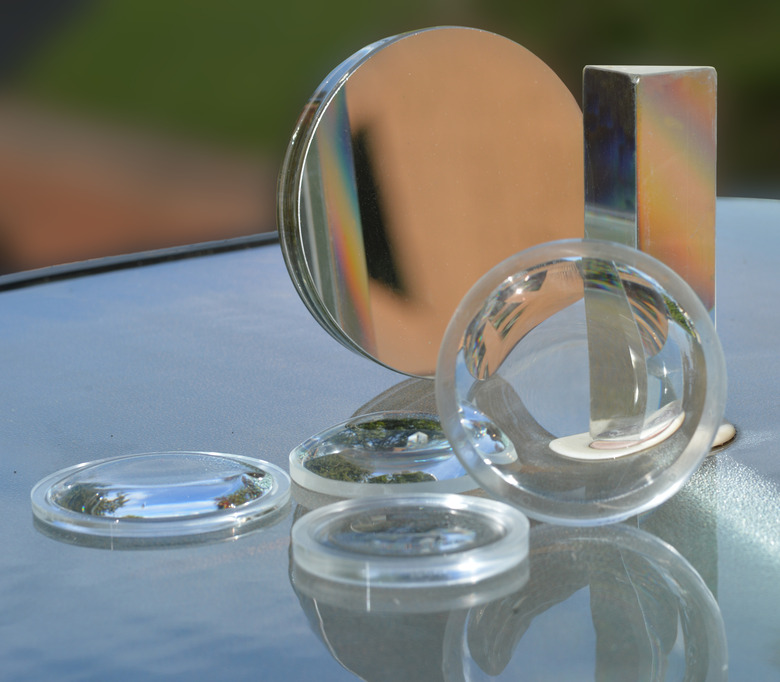Definition Of Concave Mirror
Light does not bend. A most significant property of light is that it travels in a straight line from its source to whatever surface it touches. The rays of light may be long or short; regardless, rays of light are always straight. A concave mirror is composed of a reflective surface with its sides curved closer in distance to your eye than its middle surface. Let's look at what happens to rays of light, traveling at approximately 186,000 miles per second (the speed of light), when they strike a concave mirror's surface.
Basic Physics
Basic Physics
When light travels through space, it eventually reaches a surface. If the surface is translucent, it reflects some of the light and lets some pass through. Inside translucent material the light is scattered and to our eyes the image will appear fuzzy. If the surface is transparent (glass and water, for example), most of the light will pass through its thickness until it strikes another surface. There are also opaque surfaces.
A Simple Process
A Simple Process
An ordinary flat mirror, such as one you might find in your home, consists of a surface generally made of a transparent material in a flat plane with a uniform thickness. The back of the material is coated with silver or aluminum, or some other shiny reflective substance. Light travels through the transparent material's thickness (a 1/4-inch piece of glass, for example), strikes the silver coated back of the glass and is reflected toward the direction from which it came. If you stand in front of a mirror, the light emanating from you (your surface) will enter the mirror, hit the back silver surface, and reflect (return) in your direction showing you your own image.
Alternate Effects
Alternate Effects
There are two other possibilities when it comes to mirrors: one that reflects the light rays so they appear smaller (convex) and the other that reflects rays to appear larger (concave) to our eyes. The two differently shaped mirrors act like lenses. In the simplest terms, they are curved, polished surfaces with bowed shape in relation to a flat plane. The shape may be created mechanically by varying the thickness of the surface or by bending the surface to gain the same effect.
Concave Is Not Convex: A Definition of Exclusion
Concave Is Not Convex: A Definition of Exclusion
A convex lens has a shape with a thicker middle than sides. People who can see things far away, but cannot see objects in focus close up (farsightedness or hyperopia), use convex lenses to bring the closer objects into focus. Look at the back of a spoon, for example. It is bent so that the middle remains closer to your eye than the edges. You appear to be smaller in the image, but the reflection shows your surroundings in focus as well. Convex mirrors are used in many department stores and offices, most often placed in the corners of rooms, so that more of a particular room area may be seen at the same time.
A Concave Mirror
A Concave Mirror
A concave mirror has a shape with a thinner middle and thicker sides in relation to a flat plane. People who cannot see objects in focus at a distance but can see objects close up (nearsightedness or myopia) use concave lenses to bring the farther objects in focus. Now look at your spoon again from the other side. You will see that the sides curve up closer to you and the middle is farther away from your eye. You will also see that your image is upside down. This business side of a spoon represents a concave mirror.
More on Reflection
More on Reflection
Most physics textbooks will include a discussion on the rules governing reflection. Detailed analysis reveals the inverse relationship between incident rays traveling parallel to the principal axis and through the focal point when reflected, and the opposite travel of rays parallel to the focal point and through the principal axis when reflected. Regardless how light may appear to bounce and bend, or the numerous surfaces of reflection, light travels in a straight line. The next time you visit a carnival spend some time in the House of Mirrors and witness the dynamic properties of reflected light.
Cite This Article
MLA
Telsch, Ronald Erich. "Definition Of Concave Mirror" sciencing.com, https://www.sciencing.com/definition-concave-mirror-5120634/. 13 March 2018.
APA
Telsch, Ronald Erich. (2018, March 13). Definition Of Concave Mirror. sciencing.com. Retrieved from https://www.sciencing.com/definition-concave-mirror-5120634/
Chicago
Telsch, Ronald Erich. Definition Of Concave Mirror last modified March 24, 2022. https://www.sciencing.com/definition-concave-mirror-5120634/
